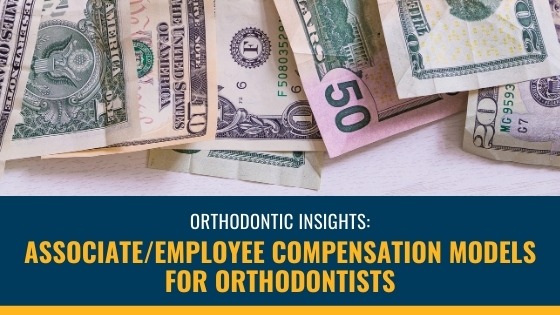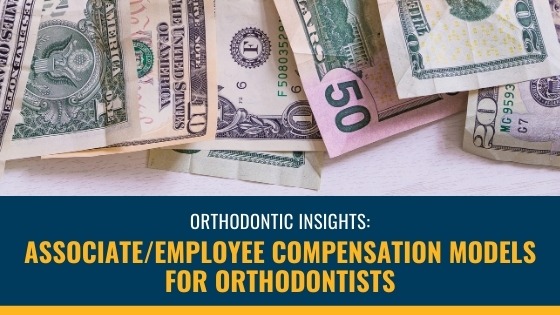
By: Shannon Patterson, CPR, CMSR
Kolbe Certified™ Consultant
Director of Practice Opportunities
We get at least one inquiry a day about associate compensation either from an associate/employee orthodontist or a potential employer. In the past, the answer to this question wan average salary range, but the pandemic changed the compensation model for many employers. Now in 2021, instead of “What is the average annual salary for an associate?” we are hearing “Is it better to have an income guarantee (salary) or be paid based on a commission of production/collections?”
One of the first questions I ask a potential associate/employee is “What is most important to you when you consider your overall compensation model?” This is somewhat of an emotional question for many associates because often these two models offer ‘certainty’ versus ‘incentive.’
What you have to ask yourself is, “Am I comfortable taking a risk for more income potential?” “Do I want to be compensated more when I increase production?” “Or do I prefer to have a higher daily rate out of the gate and know exactly what my income will be on an annual basis?”
When considering your compensation model – consider these three areas:
1. Direct Compensation – Income guarantee which is paid either as an annual salary or a per diem
2. Indirect Compensation – Benefits such as health insurance, continuing education, association dues, licensure reimbursement, and PTO
3. Deferred Compensation – Retirement plans such as 401K or profit-sharing
When looking at these three factors you must decide what is most important to you.
Let’s explore the two most popular types of compensation models in the orthodontic industry – production-based (PB) vs income guarantee (IG). It’s critical to understand the difference between these models in order to make an informed decision that’s best for you and your long-term plans and goals.
If you are a highly-motivated orthodontist, the PB compensation model may be very lucrative but you should also understand the model and formula on which you will be paid. I am receiving an increasing number of calls from associate doctors that are being offered to shift to this model after 12 months of employment. This provides you an opportunity to understand what your income potential will be, since you can examine the previous production average for the prior twelve months, minus adjustments (discounts, write-offs and insurances, and your benefits), and calculate the percentage you are being offered with the adjusted production.
Currently, the most popular model is a hybrid model of both an IG (income guarantee) and a PBI (production-based incentive) plan. This is a shift we have seen employers make post-pandemic. Many potential employers are offering a lower IG rate but a higher PBI plan. How does this plan work and what exactly do you need to know?
First and foremost, you must understand the production goal and what metrics are available for you to monitor this goal. Second, recognize, how many days per month you will work to meet this goal.
As an example, let’s say your potential employer sets a $100K monthly production goal, and you are working 16 days/per month. Simply divide $100K by 16 (clinical days worked) which equals $6,250/per day. To meet your goal, you must produce $6,250/per day which equals about 1.2 starts per day.
You must also consider the conversion rate in the orthodontic practice. If it’s 60% then you will need to see at least three new patient (NP) consults each day. When an employer hires you, they not only want you to see current patients – which is where the IG comes in – but they also expect you to see NP consults. Can a new orthodontic graduate handle three to four NP consults per day? I am sure many of you look at this and say “Of course I can. That’s easy. I can see two new patients in the morning and two in the afternoon, right?” Well, that depends…
Let’s do a bit more math. How many patients are in the clinic? If there is an average of 50 clinical patients/per day it will allow you to spend more time with each NP consult to warrant a good conversion. But what happens if you are expected to see 80-100 clinical patients/per day? This might cause a bit of a struggle for a new graduate – balancing the clinic and spending the appropriate amount of time with NP exams/consults.
So, what are some things you should note when visiting a practice to ensure you can handle the patient flow and hit your production goals? Ask any consultant and they will tell you systems, systems, systems! A practice expecting you to hit high production goals must have good systems and teams to help you meet expectations.
The difference between a well-trained Treatment Coordinator (TC) and a mediocre one can be detrimental for a new graduate. If you have a great TC and you see three-to-four NP consults/ per day, you will most likely be looking at a 70% conversion rate – which makes your target income potential reasonable. If you are considering joining a practice, ask to examine the schedule – not just for that day, but for the week and month. Find out how many NP consults the practice normally sees on a daily or weekly basis, to make sure you have a reasonable opportunity to start new patients. Another consideration is the practice’s target market. Is the practice marketing and advertising to patients who are willing to commit to treatment or are they marketing to attract shoppers? This is important to know before you join, if the majority of your income is production-based.
If you join a well-established orthodontic practice with a well-trained team that attracts the right new patients, participating in a PB compensation model versus a higher IG can be very lucrative.
Based on recent trends, the odds are good that associate compensation will continue to shift toward productivity. The more you produce the higher your income potential. Specifically, with DSO and OSO models, paying based on production bonuses shifts the risk from the employer to the associate and helps maintain healthy productivity.
So, as you interview for potential associate opportunities be sure to weigh the differences between any production-based or income guarantees you may be offered. Do your homework and ask questions of your potential employer to understand whether or not the offer works for you.
 Search Jobs
800-621-4664
Request Consult
Search Jobs
800-621-4664
Request Consult
